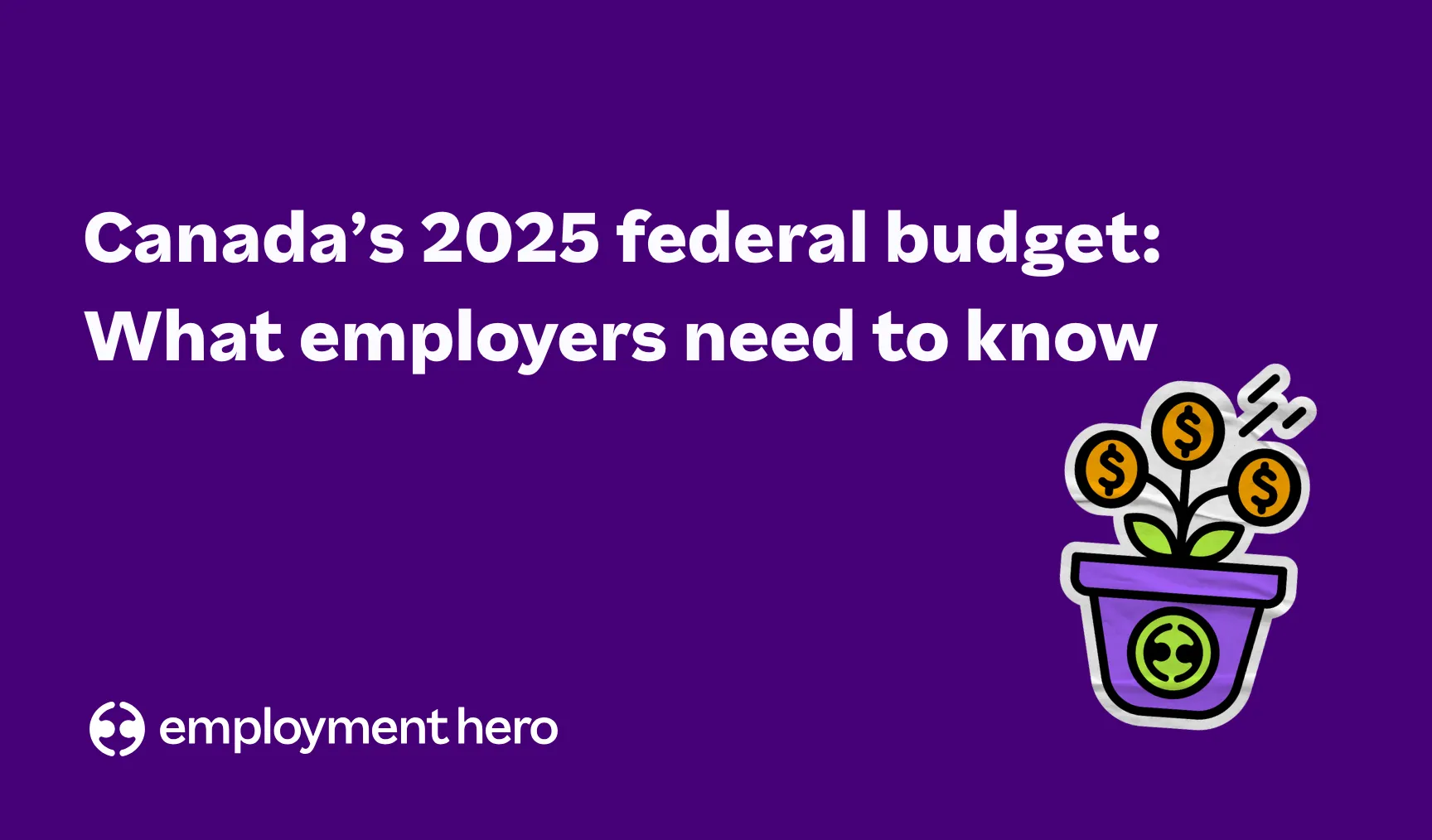How to write a job ad in Canada that attracts the right candidates
This guide shows you how to write a hiring post that’s clear, compliant and compelling for Canadian SMBs. It includes a complete step-by-step, a sample ad you can copy and a checklist for salary transparency and accessibility.

Contents
Top candidates move fast. If your job ad is vague, hard to skim or missing key details, you’ll lose them to a competitor in minutes. The good news — a standout posting isn’t luck. It’s a repeatable process you can use for every role.
Why it matters right now: Canadian workers are pragmatic and mobile. A significant share hold more than one job and many are prioritizing stability and balance. If your ad doesn’t speak to what they value and how you support it, they’ll scroll past.
This guide shows you how to write a hiring post that’s clear, compliant and compelling for Canadian SMBs. It includes a complete step-by-step, a sample ad you can copy and a checklist for salary transparency and accessibility. We’ll also point to tools that help you move from posting to great onboarding with less admin — powered by Employment Hero’s onboarding software.
What is a hiring post?
A hiring post (job ad) does two jobs at once:
- Marketing: It’s your elevator pitch to future teammates. It should make the work feel purposeful, show your culture and offer a concrete reason to hit apply.
- Compliance support: It needs to respect human rights laws, accessibility standards and pay transparency rules that apply where the job will be performed. You can’t “ensure” compliance with a single ad, but a well-built template helps you stay onside and reduce risk.
Important guardrails across Canada
- Human rights — Don’t publish ads that express or imply a preference or limitation based on protected grounds such as age, sex, disability, race or religion. That’s prohibited federally and in every province. Keep phrasing skills-based and avoid coded language like “young and energetic.”
- Accessibility — In Ontario, the AODA Employment Standard expects you to notify applicants that accommodations are available during recruitment. Add this statement to every posting, careers page and interview email.
How to write a hiring post
Writing a standout hiring post is part art, part compliance. It’s about more than listing duties — it’s your first impression with potential teammates. A well-crafted job ad should be clear, engaging and inclusive, while meeting Canadian employment and pay transparency rules. Here’s how to build one that gets noticed for all the right reasons.
1. Start with a job title
Make the title specific and searchable. Favour clarity over creativity.
- Good: Customer Support Specialist
- Better: Customer Support Specialist B2B SaaS
- Avoid jargon like Rockstar or Ninja. These terms can turn off qualified candidates and may invite bias.
2. Introduce the company
Open with 2–4 crisp lines that show why your work matters and what it feels like to work with you. Anchor on mission, product impact and your ways of working. If you’re remote, hybrid or onsite, say so. Link to your values page if you have one.
Tip: Candidates care about growth and balance. If you offer flexible work, link your flexible work policy so people can self-screen without guesswork.
3. Write a job description
Use bullets to set expectations, not overwhelm. Aim for 6–8 responsibility bullets grouped by theme. Start each line with a strong verb. Tie responsibilities to outcomes so talent can picture success. Here are some examples:
- Own the first-line response on chat and email for 60+ SMB customers
- Resolve Tier-1 issues and triage complex tickets within SLA
- Partner with Product to escalate bugs with clear reproduction steps
4. Discuss the benefits of the role
Be specific. List salary or range if required in your province (see “Salary and compensation” below). Then list benefits that candidates value today:
- Growth opportunities such as annual development budgets, mentorship and internal mobility
- Wellbeing support like EAP access and paid mental health days
- Flexibility in hours or location
- Paid parental leave and caregiver support
Streamline every step of hiring — from writing job ads to onboarding new hires — with the Employment Operating System.
Link relevant proof points. For example, if you streamline onboarding and probation, link your onboarding software, HR software or completed probation letter template so candidates see how you support a smooth start.
5. Include application information
End with everything needed to apply in one place:
- How to apply and what to include
- Deadline or request to apply early
- Who to contact for accessibility accommodations
- What happens next and your interview format
If you use AI to screen or assess applicants in Ontario, you’ll need to disclose that in publicly advertised postings starting January 1, 2026.
Tips to write an effective hiring post
Even the best-written job ad can miss the mark if it doesn’t connect with what candidates care about. These quick tips will help you polish your post so it reads clearly, feels authentic and drives the right people to apply. Each one comes from what we’ve seen work best for Canadian SMBs — and what our HR advisory team helps businesses refine every day.
Conduct thorough research
Scan 5–7 current postings for similar roles in your market. Note titles, salary bands, tech stacks and perks. Use this to calibrate your ad and range.
Talk to current employees
Ask two top performers what made them apply and what keeps them here. Borrow their language to describe the mission, impact and growth. Real words beat buzzwords.
Keep it engaging
Write like you speak. Short sentences. Plain language. Avoid filler like “fast-paced environment.” Show a day-in-the-life instead.
Keep it concise
If a bullet won’t change who applies, cut it. Most winning ads fit on one screen on mobile.
Proofread the job posting
Run a bias pass. Replace gendered words, remove age signals and double-check accommodation language. If the job is in BC or PEI — or in Ontario from 2026 — confirm the salary band is in the ad.
Hiring post example

Below is a sample you can adapt. It models inclusive language, clear expectations, an accommodation statement and pay transparency.
Job title
Customer Support Specialist B2B SaaS
About us
We help Canadian SMBs run people operations with less admin and more confidence. We’re a product-led team that cares about customer joy, not tickets closed. We work hybrid from Toronto with flexible hours.
The impact
You’ll be the human on the other side of our chat, solving problems fast and feeding insights back to Product so we ship what customers actually need.
What you’ll do
- Resolve Tier-1 support requests across chat and email within SLA
- Diagnose and document issues, escalating with clear context
- Write and update help articles customers love to read
- Spot recurring pain points and propose fixes with data
What you’ll bring
Must-haves: 1+ year in a support role, strong writing, comfort with ticketing tools
Nice-to-haves: SaaS experience, basic SQL, bilingual English-French
Compensation and benefits
Salary range: $52,000–$64,000 base, plus annual bonus and benefits
- Wellness benefits, including EAP
- $1,000 annual learning budget and access to mentorship
- Flexible hours with hybrid schedule
- 3 weeks’ vacation plus paid winter closure
Accessibility (Ontario)
We welcome applications from all qualified candidates. If you need an accommodation during any stage of the process, email talent@yourcompany.ca. We’ll work with you to meet your needs.
How to apply
Send your resume and a short note about a tricky customer problem you solved. Applications are reviewed on a rolling basis.
Ontario only — AI disclosure (Ontario)
We use AI-enabled tools to help screen applications for keywords related to required skills. Human reviewers make all interview and hiring decisions.
Required vs. preferred qualifications
Clear qualifications make your job ad more inclusive and approachable. When you separate what’s required from what’s preferred, you invite more qualified people to apply — especially those who might hesitate if they don’t tick every box.
Required qualifications are the essentials — the skills, certifications or experience someone truly needs to do the job safely or legally. Keep this list short and focused on what’s non-negotiable, like specific credentials or core technical skills.
Preferred qualifications are the nice-to-haves. They can help someone ramp up faster or bring extra value, but they shouldn’t be deal-breakers. For example, “Experience with Employment Hero HR software” or “Fluency in French and English.”
Avoid vague or exclusionary phrases like “Canadian experience.” Starting January 1, 2026, Ontario employers won’t be able to include that in job ads — and even before then, it unintentionally discourages great talent.
Not sure how to strike the right balance? Our HR advisory team can review your draft job ads and help you write qualifications that are fair, inclusive and compliant.
Unsure if your postings tick every legal and inclusivity box? The Employment Operating System includes access to expert HR guidance, templates and tools to help you hire the right people — the right way.
Understanding salary and compensation

Pay transparency isn’t just a nice-to-have anymore — it’s fast becoming a legal and cultural expectation across Canada. Candidates want clarity from the start, and governments are backing that up with new regulations that require salary information in job ads.
Here’s what you need to know about salary transparency laws across Canada, and how to keep your job ads compliant (and appealing) no matter where you hire.
Legal requirements for salary transparency
- British Columbia — Employers must include the expected pay or pay range in all public job postings. BC also bans seeking pay history and protects pay discussions.
- Prince Edward Island — Since 1 June 2022, publicly advertised job postings must include the expected pay or a pay range. Employers can’t ask for pay history.
- Ontario — New rules take effect 1 January 2026. Publicly advertised postings must include expected compensation or a range; if using a range, it cannot exceed $50,000 unless the role pays over $200,000 annually. Postings must also disclose the use of AI in screening/assessing, state whether the role is an existing vacancy and you must inform interviewed applicants of the decision within 45 days.
- Newfoundland and Labrador — The Pay Equity and Pay Transparency Act is in force in part, with pay transparency regulations pending for broader application. Watch for final regulations before posting.
Best practice everywhere: Share total compensation up front — base pay, bonus/commission, equity, if any, and benefits highlights. If you operate in multiple provinces, build your template to meet the strictest rules so you can reuse it with minimal edits.
Human rights reminder: Don’t publish ads that prefer certain ages, genders or other protected characteristics. This is prohibited under federal and provincial human rights laws. Keep the criteria job-related and neutral.
A standout job ad is your best recruitment tool
When you get your job ads right, everything else in hiring becomes easier. The right people find you faster, your interviews become more meaningful and your onboarding flows naturally into long-term engagement.
Writing a great job ad isn’t about luck — it’s about clarity, inclusivity and trust. And with the right tools behind you, it’s something every Canadian employer can master.
Before you hit publish, make sure your next posting checks every box: clear title, inclusive language, pay transparency and a strong sense of who you are as an employer. Then bring it to life with Employment Hero’s HR software, onboarding software and guidance from our HR advisory experts.
Frequently Asked Questions
A strong Canadian job ad should include a clear job title, company introduction, responsibilities, required and preferred qualifications, compensation details, benefits and accessibility information. Employers in provinces like Ontario, BC and PEI must also include salary ranges to comply with pay transparency laws.
Yes, several provinces have enacted or announced pay transparency laws.
- BC and PEI already require salary or pay range disclosure in public job postings.
Ontario will require salary transparency and AI disclosure in job ads starting January 1, 2026.
Sharing pay ranges not only keeps you compliant but also builds trust with candidates.
To comply with Canadian human rights standards, avoid language that could imply bias based on age, gender, race, disability, or religion. Focus your wording on skills and job-related qualifications, and include a statement offering accommodations during recruitment to meet AODA requirements in Ontario.
A job description outlines internal expectations and duties, while a job ad (hiring post) is a marketing tool to attract the right candidates. A job ad highlights company culture, benefits, and purpose, and uses inclusive, engaging language to inspire applications.
Canadian SMBs can write inclusive job ads by using plain language, avoiding gendered or coded terms, listing accommodation availability, and separating required from preferred qualifications. This helps attract more diverse, qualified applicants and aligns with federal and provincial human rights laws.
Starting January 1, 2026, Ontario employers must disclose in any public job posting if AI is used to screen or assess applicants. Employers must also state whether a job is an existing vacancy and notify interviewed applicants of the final hiring decision within 45 days.
Platforms like Employment Hero’s HR software and onboarding tools help streamline the hiring process — from writing job ads to managing new hires. They include templates, compliance checklists, and HR advisory support to ensure your postings are inclusive, compliant, and effective.
Related Resources
-
 Read more: 8 Email Holiday Templates for Every Workplace
Read more: 8 Email Holiday Templates for Every Workplace8 Email Holiday Templates for Every Workplace
Struggling to write your out-of-office message? Copy our 8 free holiday email templates for Christmas and New Year to set…
-
 Read more: 2025 federal budget: What Canadian employers need to know
Read more: 2025 federal budget: What Canadian employers need to know2025 federal budget: What Canadian employers need to know
Discover what Canada’s 2025 federal budget means for employers, from enhanced SR&ED incentives to new talent and funding opportunities.
-
 Read more: What tech founders should know about the 2025 federal budget and why this year is the perfect time to double down on SR&ED
Read more: What tech founders should know about the 2025 federal budget and why this year is the perfect time to double down on SR&EDWhat tech founders should know about the 2025 federal budget and why this year is the perfect time to double down on SR&ED
Discover how the 2025 federal budget enhances SR&ED for Canadian startups. Learn how founders can maximize refunds, extend runway and…


















